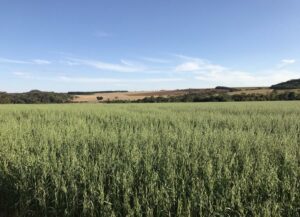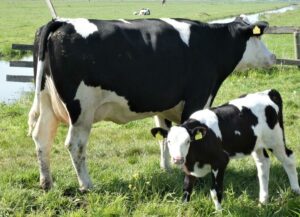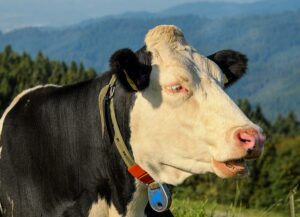Álvaro García
The phrase “dual purpose or breeds with no purpose?” was thrown out in a cattle discussion forum not so long ago. The claim was that animals bred for both milk and beef could never excel at either, making them a compromise halfway between one and the other. Another contributor stated: “There is no such thing as dual-purpose cattle; the dual purpose lies with the farmer. Cattle are either for beef or for milk; whether the line is for meat or for milk, it requires the management care necessary to achieve the expected results.” From my perspective, such views overlook the very origins of cattle husbandry, as well as the fact that several modern breeds excel in both milk and beef production. The problem is that dual-purpose animals in the tropics (these comments were from that region of the world) are sometimes crossed with breeds that ‘tank’ milk production while cutting daily weight gains by as much as half.
Let us keep in mind that from ancient times however, cattle were multifunctional. Inscriptions on Egyptian temples depict cows being milked, hauling grain, slaughtered for beef, and sacrificed in religious rituals. Later in history, cattle warmed the dwellings where social groups slept, pulled plows, and provided milk and calves. In many parts of the world, they still fulfill social roles, serving as dowry, savings, or currency among certain tribes. To deny their multiple functions is to deny their very essence.
This article explores their comparative advantages, production metrics, environmental adaptability, and socioeconomic impact, while ranking key breeds and analyzing crossbreeding strategies.
Comparative advantages of dual-purpose breeds
Dual-purpose cattle offer farmers a way to spread risk and make fuller use of each animal. Instead of focusing exclusively on milk or beef, these breeds provide both streams of income, which can be especially valuable where markets fluctuate, or resources are limited. By consolidating roles, they often reduce input costs compared to running separate specialized herds.
Another strength is adaptability. Dual-purpose breeds can handle variation in feed quality and climate conditions better than highly-specialized breeds. This makes them well-suited for extensive grazing systems, mixed farming, and smallholder operations that cannot guarantee high-quality feed year-round. It is true that they will not reach the extreme milk yields of Holsteins or the rapid growth rates of Angus. However, what they deliver is a balance: steady milk output, respectable beef value, and often greater fertility and longevity. In practice, this means fewer replacements, lower veterinary costs, and more predictable returns across the animal’s lifetime.
Breed potential: milk and beef together
When evaluating dual-purpose breeds, it helps to look at how they balance milk yield, milk components, and carcass quality. Some standouts illustrate the range of possibilities:
Simmental/Fleckvieh cows, for example, can produce between 7,000 and 11,000 kilograms of milk per lactation with butterfat levels around 4 percent. At the same time, their calves grow quickly and develop excellent muscling, making them attractive for both milk and beef operations. This combination of traits explains why some modern dairy farms have begun introducing Simmental genetics into their Holstein herds. While Holsteins are unrivaled in peak milk output, their male calves often have little economic value, selling at a discount compared to beef breeds. By incorporating Simmental bloodlines, these dairies maintain strong milk yields but also add carcass quality and growth potential to the offspring. The result is a system where both male and female calves carry market value, heifers as productive milkers, and bull calves as profitable feeders rather than low-value byproducts.
In regions where calf prices are an important part of farm income, this strategy provides a significant advantage. It reflects a broader shift away from purely maximizing milk yield toward balancing productivity with overall herd value and market resilience.
Brown Swiss are another case in point: their milk is not only abundant but also rich in protein and fat, which is highly valued for cheese-making. These cows also produce solid carcasses and are renowned for their disease resistance and resilience under varied conditions.
The Normande, a French breed, excels at butterfat-rich milk that drives high cheese yields, while also delivering flavorful, well-marbled beef. Shorthorns, depending on the line, can lean more toward dairy or beef but are often chosen for their versatility and relatively early maturity. And at the smallholder end of the spectrum, Dexters produce modest volumes of high-fat milk alongside lean, tender beef, fitting neatly into low-input or self-sufficient systems.
Matching breeds to the environment
The performance of dual-purpose cattle depends heavily on the environment in which they are raised. In temperate regions, breeds like Simmental and Brown Swiss thrive in pasture-based systems with moderate climates and abundant forage. In tropical and subtropical zones, however, crossbreds truly come into their own. The Girolando (Holstein × Gyr) is perhaps the best-known example, combining the high milk potential of Holstein with the heat tolerance and parasite resistance of the Gyr. This cross has transformed dairy production in Brazil and is now spreading across much of Latin America and other tropical regions.
A major strength of dual-purpose breeds is their ability to cope with medium-quality forage. While purebred Holsteins often struggle outside intensive systems, dual-purpose cattle maintain steady milk and meat output, particularly when supplemented strategically. This adaptability makes them invaluable where feed quality fluctuates or where grain supplementation is limited.
Crossbreeding plays a key role in maintaining and enhancing this resilience. Simmental × Zebu cattle, for instance, combine muscling and growth potential with tropical hardiness, while Holstein × Gyr crosses provide high milk yields under heat and disease pressure. To sustain these advantages, structured breeding programs are essential, as the hybrid vigor (heterosis) seen in F1 animals can decline in later generations if breeding is left unmanaged. When applied carefully, however, crossbreeding strategies create cattle capable of thriving in challenging conditions without sacrificing productivity.
Examples of successful dual-purpose crosses |
||
Cross |
Key strengths |
Common regions |
Girolando (Holstein × Gyr) |
High milk yield, heat tolerance, parasite resistance |
Brazil, Latin America, Asia |
Simmental × Zebu |
Strong muscling, faster growth, tropical hardiness |
Latin America, Africa |
Normande × Criollo |
Rich milk for cheese, durable in low-input systems |
Andes, Central America |
Brown Swiss × Local Breeds |
Protein-rich milk, longevity, adaptability |
South Asia, East Africa |
Production and economic realities
On average, dual-purpose cows yield between 4,000 and 8,000 kilograms of milk per lactation less than Holsteins but far more than beef breeds. In tropical settings, Girolando cows can more than double the yield of pure Gyr cattle, highlighting the power of crossbreeding in resource-limited systems.
On the beef side, growth rates are moderate to high, with many dual-purpose steers grading well for both yield and quality. Economically, their greatest strength lies in flexibility: milk provides regular daily income, while beef offers a lump sum at culling or seasonal sale. This diversification reduces dependence on a single market and helps households remain resilient when prices swing. Their longevity and adaptability also mean lower replacement and veterinary costs, improving profitability over the animal’s lifetime.
Performance of key dual-purpose breeds by environment |
||
Breed |
Temperate regions |
Tropical/subtropical regions |
Simmental/Fleckvieh |
High milk (7,000–11,000 kg), strong carcasses, excels on quality forage |
Performs adequately with supplementation, less heat-tolerant |
Brown Swiss |
High-component milk (protein & fat), strong longevity, pasture-adapted |
Good disease resistance, tolerates moderate heat stress |
Normande |
Butterfat-rich milk, excellent for cheese, flavorful beef |
Performs best in cooler highland tropics; less suited to humid lowlands |
Shorthorn |
Balanced dairy/beef output, adaptable to medium-scale farms |
Limited use; struggles with heat unless crossed |
Dexter |
Suited for low-input, self-sufficient systems, small landholders |
Performs in smallholder tropical systems when well managed |
Social and cultural significance
Beyond economics, dual-purpose breeds carry enormous social importance in much of the world. In Latin America, Asia, and Africa, they sustain rural livelihoods. Families often depend on daily milk sales for cash flow, while beef provides seasonal income and nutritional security. In Colombia, for instance, dual-purpose systems account for more than 60 percent of national milk production. Their year-round contribution to both household nutrition and market stability makes them far more than just production animals.
These cattle also maintain cultural significance. In some communities, they serve as dowry, social currency, or a visible store of wealth. In others, they are a measure of social status or a source of pride in community events and festivals. They represent not only production but also identity and resilience, tying rural families to their land and traditions, and ensuring continuity across generations.
Economic comparison: dual-purpose vs. specialized systems |
||||
System / breed type |
Avg. milk yield (kg/lactation) |
Male calf value (USD) |
Cow longevity (lactations) |
Key economic notes |
Holstein (specialized dairy) |
9,000–12,000 |
$25–75 (low beef value) |
2.5–3 |
High milk revenue but short lifespan; male calves often unprofitable |
Angus (specialized beef) |
– (not dairy) |
$300–500 (feeder calf) |
– |
Excellent beef returns, but no milk income; requires separate dairy/beef herds |
Simmental/Fleckvieh (dual-purpose) |
7,000–11,000 |
$200–350 |
4–5 |
Balanced income from milk + beef; calves much more valuable than Holstein bull calves |
Brown Swiss (dual-purpose) |
6,000–9,000 |
$150–250 |
4–6 |
Strong longevity offsets slightly lower milk; solid beef carcass value |
Girolando (Holstein × Gyr) |
4,000–6,000 (tropical) |
$100–200 |
4–5 |
Adapted to heat and parasites; crossbred calves carry both dairy and beef value |
Conclusion
Dual-purpose cattle are not a compromise without direction, as critics sometimes argue. They are, in fact, a return to the roots of cattle husbandry, animals that serve multiple needs, from milk and meat to social and cultural roles. While specialization has created record-breaking yields, it has also exposed producers to fragility. In contrast, dual-purpose breeds offer resilience, adaptability, and a more complete use of resources. In many regions of the world, they remain the backbone of sustainable livestock systems, and perhaps a reminder that versatility is itself a form of strength.
© 2025 Dellait Knowledge Center. All Rights Reserved.









